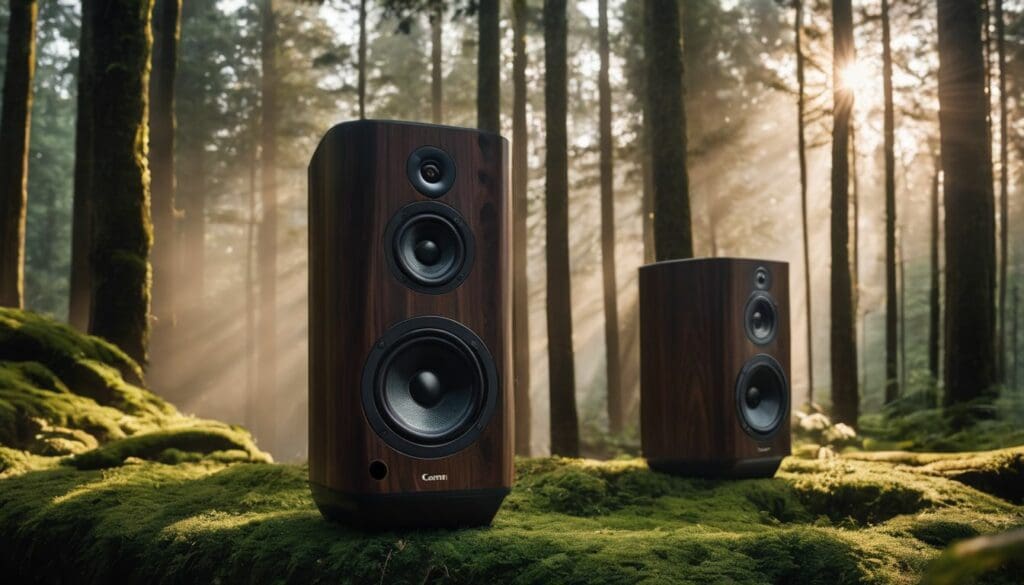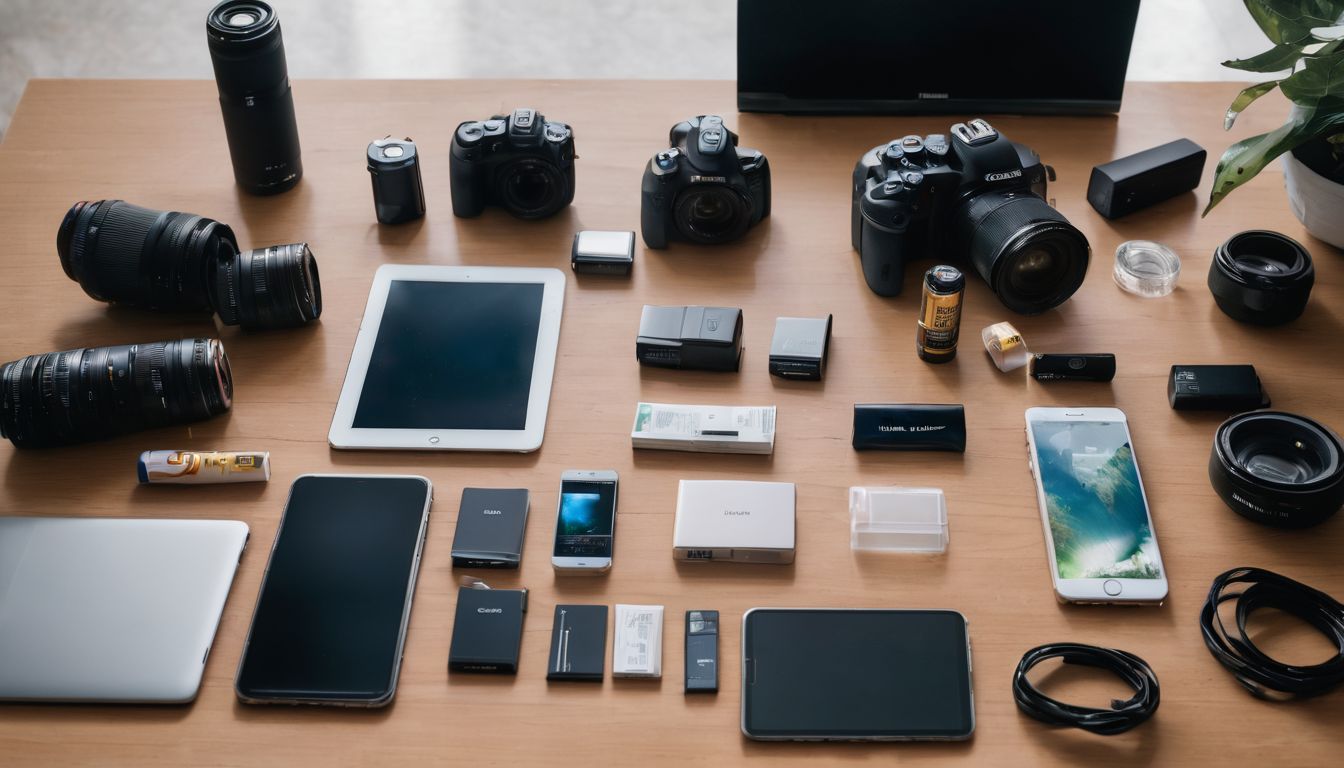We’re all rather fond of our favourite tracks, but have you ever spared a thought for the environmental impact that comes with our traditional listening devices? If you’re anything like us, there’s a twinge of eco-conscious concern every time we plug into those speakers or headphones which aren’t exactly the best pals to good old Mother Earth.
With a staggering 50 million tonnes of e-waste accumulating around the world annually, it’s high time we face the music. Our exploration into sustainable audio equipment is set to be your handbook for enjoying beats responsibly – so let’s crank up the sustainability dial and make some noise for the planet!
Key Takeaways
- Sustainable audio equipment uses materials like bamboo, organic cotton and recycled plastic to lower environmental impact while ensuring high-quality sound.
- Alternative energy sources such as solar and kinetic power are increasingly being incorporated into eco-friendly speakers to reduce reliance on non-renewable resources.
- Brands offering repair workshops, recycling schemes and trade-in programs help extend the life of audio devices, which reduces e-waste and supports a more sustainable planet.
- Advancements in technology are paving the way for improved sustainable sound systems that focus on durability, recyclability and energy efficiency without compromising on performance.
- Consumers have a growing selection of eco-conscious brands like gomi and House of Marley that produce Bluetooth speakers from non-recyclable waste materials, advocating for both top-notch audio experiences and environmental responsibility.
Understanding Sustainable Technology
When it comes to sustainable audio technology, it’s crucial to understand the impact of non-sustainable equipment and the benefits of choosing recyclable materials, alternative power sources, durability and repair schemes.
This section will delve into these key aspects of sustainable sound technology.
The Impact of Non-Sustainable Audio Equipment
Non-sustainable audio equipment often ends up in landfills, contributing to environmental damage. These products are typically made from materials that do not break down easily and can release harmful chemicals as they decompose.
Every set of non-eco-friendly headphones or speakers discarded irresponsibly adds to the growing problem of electronic waste. This e-waste contains plastics, heavy metals, and other pollutants that can harm soil quality and water sources.
We see a dramatic use of energy in the production and use of traditional sound systems. Many devices aren’t designed with energy efficiency in mind, leading to a larger carbon footprint over their lifetime.
Also, these items rarely offer options for repair or recycling when they break or become outdated. As we push towards greener alternatives in technology, recognising these impacts is crucial for steering our choices towards more eco-conscious audio experiences.
Choosing Recyclable and Sustainable Materials
When selecting audio equipment, we opt for recyclable and sustainable materials to reduce our environmental impact. Prioritising eco-friendly components such as bamboo, recycled plastic, or aluminium helps lessen the use of virgin resources and minimises waste.
Our choices can also support companies that uphold ethical sourcing practices and promote fair trade. By choosing sustainably sourced and recyclable materials in our audio equipment, we contribute to a more environmentally friendly industry while enjoying quality sound experiences.
Incorporating sustainable materials into audio equipment not only benefits the environment but also encourages innovation within the industry. From headphones to speakers, utilising renewable resources like organic cotton or cork can elevate both design and functionality while reducing our ecological footprint.
Incorporating Alternative Sources of Power
When considering sustainable audio equipment, it’s essential to look at alternative sources of power. Renewable energy options such as solar and kinetic power offer eco-friendly alternatives to traditional electricity.
Incorporating these sources of power into audio equipment reduces the reliance on non-renewable resources, making a positive impact on the environment. By embracing renewable energy solutions, manufacturers can create more environmentally friendly audio devices that align with the values of eco-conscious individuals.
In addition to using recyclable materials in our sound systems, we are actively exploring alternative power sources for our products. As we continue to innovate in this area, we aim to provide consumers with sustainable audio technology that is both energy-efficient and environmentally friendly.
Repair and Recycling Schemes
We can contribute to a sustainable environment by supporting repair and recycling schemes within the audio equipment industry. Here are some ways in which these schemes benefit the environment and promote eco-friendly practices:
- Repair Workshops: Brands offering repair workshops encourage customers to bring in their faulty equipment for repairs instead of discarding them, reducing electronic waste.
- Upcycling Initiatives: Some companies engage in upcycling old or broken audio equipment, turning them into new, functional products while diverting waste from landfills.
- Trade-in Programmes: Many audio equipment manufacturers operate trade-in programmes where old devices can be exchanged for discounts on new, energy-efficient models.
- Responsible Disposal Policies: Brands implement responsible disposal policies, ensuring that outdated or unusable equipment is recycled properly to minimise environmental impact.
- Extended Product Lifespan: By offering repair services and encouraging responsible disposal, the lifespan of audio equipment is extended, reducing the need for constant replacements.
- Reusable Packaging: Some brands adopt reusable packaging solutions for shipping repaired or refurbished products, minimising disposable packaging waste.
- Education Campaigns: Engaging in educational campaigns about proper electronic waste disposal and promoting the benefits of repairing over replacing helps raise awareness about sustainability in the audio equipment industry.
Prioritising Durability and Longevity
Transitioning from the importance of repair and recycling schemes to prioritising durability and longevity, we recognise the significance of investing in audio equipment that stands the test of time.
Choosing sustainably sourced materials, such as bamboo, recycled aluminium, or FSC-certified wood, ensures that products maintain their quality for years to come. Prioritising durability means opting for well-built and sturdy devices that resist wear and tear, reducing the need for frequent replacements.
Longevity in audio equipment goes hand in hand with sustainability by minimising environmental impact through extended product lifespan.
Sustainable living products advocate for energy-efficient sound systems that are designed to last. This shift towards environmentally friendly audio equipment encourages consumers to consider longevity as a key factor when making purchasing decisions.
The Future of Sustainable Audio Technology
As advancements in sustainable technology continue to evolve, the future of sustainable audio technology is promising. Manufacturers are exploring innovative ways to create audio equipment that minimizes environmental impact while enhancing performance.
The focus is on developing eco-friendly materials, energy-efficient power sources, and recyclable components for sound systems and speakers. Additionally, the integration of renewable energy sources and the implementation of repair and recycling schemes are becoming key features in sustainable audio technology.
As a result, environmentally conscious individuals can look forward to high-quality audio experiences that align with their commitment to conservation.
Moving forward into this exciting era of sustainable audio technology, we anticipate an even greater emphasis on eco-friendly practices across the entire audio industry – from production and design to usage and disposal.
It’s clear that sustainability will shape the future landscape of audio equipment as manufacturers strive to meet the demands of environmentally conscious consumers.
4. Sustainable Speakers: Redefining Audio Quality.
Sustainable Speakers: Redefining Audio Quality
When it comes to sustainable speakers, the focus is not only on reducing environmental impact but also on delivering high-quality audio experiences. With a history rooted in eco-friendly practices and innovative designs, sustainable speakers are redefining what it means to enjoy great sound while being environmentally conscious.
History of Sustainable Speakers
Sustainable speakers have a history rooted in the pursuit of reducing environmental impact. Manufacturers started focusing on using recyclable materials, offering repair and recycling schemes, and incorporating alternative sources of power.
This shift resulted from increasing consumer awareness about the ecological footprint of products. Brands like gomi and House of Marley have championed sustainable speaker production by creating high-quality audio devices from reclaimed materials, ushering in a new era of ecofriendly audio equipment that resonates well with environmentally conscious individuals.
Moving forward to “Environmental Impact of Non-Sustainable Speakers”, it’s important to understand how traditional speakers contribute to environmental degradation and explore ways to address these challenges through sustainable practices.
Environmental Impact of Non-Sustainable Speakers
Manufacturing non-sustainable speakers contributes to environmental degradation due to the extraction of raw materials, energy consumption in production, and waste generation. The use of non-recyclable materials and toxic components further exacerbates their impact on ecosystems and human health.
Additionally, these products have a shorter lifespan, leading to increased electronic waste disposal. This cycle perpetuates resource depletion and pollution, highlighting the need for sustainable alternatives in audio equipment.
Non-sustainable speakers are often designed with little consideration for energy efficiency, resulting in higher power consumption and carbon emissions throughout their lifecycle. Moreover, their inefficient manufacturing processes lead to unnecessary resource exploitation and greenhouse gas emissions.
Features to Look For in Sustainable Speakers
After understanding the environmental impact of non-sustainable speakers, it’s crucial to look for specific features that define sustainable speakers. Here are the key elements to consider when choosing sustainable speakers:
- Recyclable Materials: Look for speakers made from recyclable materials such as aluminium, bamboo, or even recycled plastic to reduce environmental impact.
- Energy-Efficiency: Opt for speakers with an energy-efficient design and components to minimise power consumption and promote eco-friendly operation.
- Minimal Packaging: Choose speakers with minimal and recyclable packaging to reduce waste and support sustainable practices from production to disposal.
- Repairability: Prioritise speakers that are designed for easy repair and maintenance, prolonging their lifespan and reducing electronic waste.
- Sustainable Production Practices: Consider brands that prioritise ethical sourcing, fair labour practices, and sustainable manufacturing methods in producing their speakers.
- Longevity: Seek out speakers known for their durability and longevity, which reduces the frequency of replacements and contributes to a more sustainable lifestyle.
- End-of-Life Options: Look for brands that offer recycling programmes or provide guidance on how to properly recycle or dispose of their products at the end of their lifecycle.
- Eco-Friendly Certification: Choose speakers with recognised eco-certifications such as Energy Star or EPEAT that validate their environmental performance and sustainability claims.
Top Sustainable Brands (gomi, House of Marley)
When considering sustainable audio equipment, it’s important to support brands that prioritise eco-friendly practices. Here are two top sustainable brands that align with environmentally conscious values:
- Gomi: This brand is known for creating Bluetooth speakers and chargers from non-recyclable plastic waste, diverting it from landfills. They also offer a circular design scheme, allowing customers to return their products for refurbishment or recycling at the end of their life cycle.
- House of Marley: With a focus on creating eco-conscious headphones and speakers, this brand uses natural and recycled materials such as bamboo, reclaimed wood, and organic cotton. Their commitment to sustainability extends to their packaging, which is made from recycled materials and responsibly sourced FSC-certified paper.
Innovative Eco-Friendly Theatres
Embracing sustainable sound design in theatres is crucial for creating eco-friendly soundscapes that enhance the audience’s experience while minimising environmental impact. By prioritising acoustics and sustainable materials, innovative eco-friendly theatres are leading the way in environmentally conscious audio experiences.
The Importance of Acoustics
Acoustics play a crucial role in creating immersive and high-quality audio experiences. When considering sustainable sound technology, the importance of acoustics cannot be overstated.
By prioritising eco-friendly materials and designs, we can ensure that sound is not only environmentally conscious but also of exceptional quality. Sustainable acoustics contribute to reducing the environmental impact while delivering an enriching auditory experience for consumers who value conservation and eco-consciousness.
Optimising acoustics in sustainable audio equipment allows for minimal energy consumption without compromising on sound quality. This aspect caters to the growing demand for low-impact sound technology among environmentally conscious individuals, aligning with the ethos of sustainability and responsible consumption.
Embracing Sustainable Sound Design
Embracing sustainable sound design involves integrating eco-friendly materials and energy-efficient technology into audio equipment. By prioritising recyclable and sustainable materials, such as bamboo, recycled plastic, or organic cotton, we can reduce the environmental impact of audio devices.
Additionally, incorporating alternative sources of power, like solar or kinetic energy, allows for lower carbon emissions and greater sustainability in our sound systems. Repair and recycling schemes further contribute to a circular economy and minimise waste in the audio industry.
When creating eco-friendly theatres or soundscapes, acoustics play a crucial role in enhancing the overall experience for environmentally conscious individuals looking for low-impact sound technology.
Advantages of Sustainable Theatres
Sustainable theatres offer numerous benefits, such as reducing environmental impact and enhancing the overall audio experience. Here are several advantages of opting for sustainable theatres:
- Improved acoustics that elevate the sound quality and overall performance.
- Reduced energy consumption through efficient lighting and sound systems, contributing to a lower carbon footprint.
- Use of eco – friendly materials in construction and decor, promoting sustainability throughout the theatre.
- Enhanced audience experience with immersive, environmentally conscious audio technology.
- Contribution to supporting conservation and environmental initiatives within the entertainment industry.
- Integration of renewable energy sources for powering audio and lighting systems, aligning with eco-friendly practices.
- Emphasis on creating eco – friendly soundscapes that resonate with environmentally conscious individuals.
Creating Eco-Friendly Soundscapes
Transitioning from the advantages of sustainable theatres, creating eco-friendly soundscapes involves integrating nature-inspired designs and materials to reduce environmental impact.
By incorporating renewable and recyclable elements in audio equipment, we can significantly lower the carbon footprint of sound technology. Embracing sustainable sound design encourages innovation in using eco-conscious materials such as bamboo, cork, and recycled plastics for speakers and headphones while maintaining high-quality audio experiences.
Developing eco-friendly soundscapes also entails prioritising energy-efficient systems that minimise power consumption without compromising performance. Leveraging acoustic principles with sustainable materials can lead to the creation of environmentally friendly music spaces that promote a harmonious blend of technology and nature.
The Rise of Eco-Friendly Bluetooth Speakers
Eco-friendly Bluetooth speakers have gained popularity due to their use of sustainable materials and energy-efficient designs, offering environmentally conscious users a guilt-free audio experience.
To learn more about the innovative advancements in sustainable audio technology, keep reading our blog.
Materials Used and Their Impact
When selecting materials for eco-friendly Bluetooth speakers, it’s essential to consider their environmental impact. By opting for sustainable and recyclable materials like bamboo, natural rubber, or recycled plastic, we can reduce the carbon footprint of our audio equipment.
These materials not only lower energy consumption during manufacturing but also decrease waste generation.
Choosing eco-conscious materials is crucial in promoting a greener approach to sound technology. By prioritising renewable resources and low-impact production methods, we pave the way for a more sustainable future in audio equipment design.
Importance of Eco-Friendly Speakers
Eco-friendly speakers play a crucial role in reducing the environmental impact of audio equipment. They are crafted from recyclable materials, offering energy-efficient sound systems that align with sustainable living values.
These environmentally conscious speakers promote low-impact sound technology, contributing to eco-friendly audio experiences and supporting conservation efforts.
The advancements in sustainable AV technology have paved the way for eco-conscious headphones and Earth-friendly music equipment as individuals continue to embrace renewable audio equipment.
Embracing sustainable sound systems not only improves the environmental footprint but also enhances the overall audio experience, making it an essential choice for those passionate about sustainability and environmentalism in sound technology.
Sustainable Designs in Bluetooth Speakers
Sustainable designs in Bluetooth speakers focus on eco-friendly materials, energy-efficient technology, and innovative design.
- Using Recyclable and Sustainable Materials: Sustainable Bluetooth speaker brands like gomi and House of Marley prioritise using recycled plastics, bamboo, or other sustainable materials in their construction to minimise environmental impact.
- Energy-efficient Technology: Eco-conscious Bluetooth speakers incorporate low-power consumption components for an energy-efficient audio experience, reducing the overall environmental footprint.
- Innovative Design Features: These speakers boast sleek and modern designs that not only look aesthetically pleasing but also optimise space and reduce material usage.
- Incorporating Alternative Sources of Power: Some sustainable Bluetooth speakers integrate solar panels or kinetic energy technology to power the device, embracing alternative sources of energy.
- Durability and Longevity: The emphasis is on creating durable products that are built to last, reducing the frequency of replacements and minimising waste.
Overcoming Challenges in Sustainable Design.
We understand the challenges of designing sustainable audio equipment. Adapting to eco-friendly materials and production processes can be difficult, but it’s essential for creating low-impact sound technology.
Finding ways to balance performance and sustainability is a constant challenge, as we aim to create energy-efficient sound systems without compromising on audio quality. Embracing innovation in design and manufacturing allows us to overcome these obstacles, ensuring that eco-conscious headphones and earth-friendly music equipment are not only possible but also desirable for environmentally conscious individuals.
Incorporating recyclable and sustainable materials offers a solution to the ecological impact of non-sustainable speakers while prioritising durability ensures longevity. Repair schemes contribute significantly towards overcoming challenges by promoting a circular economy for audio devices.
Conclusion
In conclusion, sustainable audio equipment is revolutionising the industry by prioritising eco-friendly materials and energy-efficient technology. Manufacturers are embracing innovative practices to create low-impact sound systems that provide exceptional audio quality.
Individuals seeking environmentally friendly audio devices can now choose from a wide range of sustainable options, contributing to conservation efforts through their entertainment choices.
As the demand for eco-conscious headphones and speakers continues to grow, sustainable living and audio equipment will play an increasingly significant role in supporting environmental preservation.
FAQs
1. What is sustainable audio equipment?
Sustainable audio equipment includes energy-efficient sound systems, eco-friendly Bluetooth speakers, and headphones that aim for a low environmental impact.
2. Why are people choosing eco-conscious headphones?
People opt for eco-conscious headphones because they offer an environmentally friendly way to enjoy music while supporting sustainable living practices.
3. How do eco-friendly Bluetooth speakers work?
Eco-friendly Bluetooth speakers use energy-efficient technology to deliver high-quality audio experiences without harming the environment.
4. Can buying green audio gear make a difference?
Absolutely! Purchasing green audio gear promotes the use of sustainable music technology and contributes to reducing your carbon footprint.
5. Are there many options for earth-friendly music equipment on the market?
Yes, there’s a growing range of earth-friendly music equipment including ecofriendly AV technology, which provides consumers with more choices for creating ecoconscious audio experiences.





